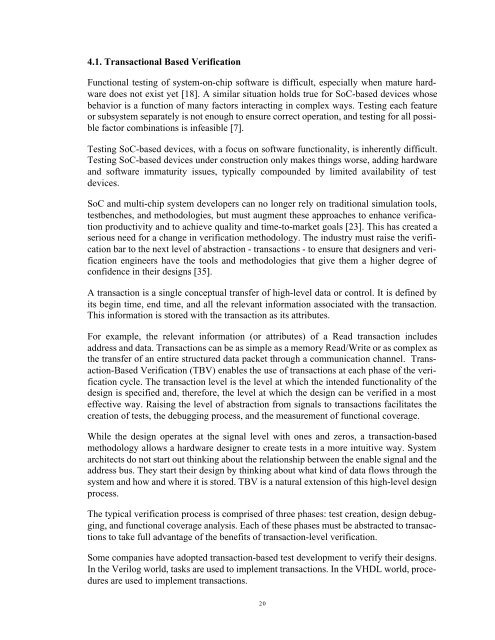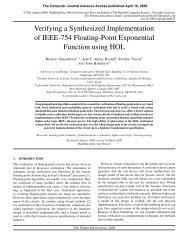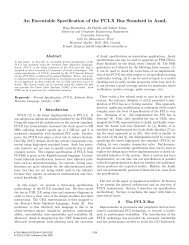PDF File - Hardware Verification Group - Concordia University
PDF File - Hardware Verification Group - Concordia University
PDF File - Hardware Verification Group - Concordia University
Create successful ePaper yourself
Turn your PDF publications into a flip-book with our unique Google optimized e-Paper software.
4.1. Transactional Based <strong>Verification</strong><br />
Functional testing of system-on-chip software is difficult, especially when mature hardware<br />
does not exist yet [18]. A similar situation holds true for SoC-based devices whose<br />
behavior is a function of many factors interacting in complex ways. Testing each feature<br />
or subsystem separately is not enough to ensure correct operation, and testing for all possible<br />
factor combinations is infeasible [7].<br />
Testing SoC-based devices, with a focus on software functionality, is inherently difficult.<br />
Testing SoC-based devices under construction only makes things worse, adding hardware<br />
and software immaturity issues, typically compounded by limited availability of test<br />
devices.<br />
SoC and multi-chip system developers can no longer rely on traditional simulation tools,<br />
testbenches, and methodologies, but must augment these approaches to enhance verification<br />
productivity and to achieve quality and time-to-market goals [23]. This has created a<br />
serious need for a change in verification methodology. The industry must raise the verification<br />
bar to the next level of abstraction - transactions - to ensure that designers and verification<br />
engineers have the tools and methodologies that give them a higher degree of<br />
confidence in their designs [35].<br />
A transaction is a single conceptual transfer of high-level data or control. It is defined by<br />
its begin time, end time, and all the relevant information associated with the transaction.<br />
This information is stored with the transaction as its attributes.<br />
For example, the relevant information (or attributes) of a Read transaction includes<br />
address and data. Transactions can be as simple as a memory Read/Write or as complex as<br />
the transfer of an entire structured data packet through a communication channel. Transaction-Based<br />
<strong>Verification</strong> (TBV) enables the use of transactions at each phase of the verification<br />
cycle. The transaction level is the level at which the intended functionality of the<br />
design is specified and, therefore, the level at which the design can be verified in a most<br />
effective way. Raising the level of abstraction from signals to transactions facilitates the<br />
creation of tests, the debugging process, and the measurement of functional coverage.<br />
While the design operates at the signal level with ones and zeros, a transaction-based<br />
methodology allows a hardware designer to create tests in a more intuitive way. System<br />
architects do not start out thinking about the relationship between the enable signal and the<br />
address bus. They start their design by thinking about what kind of data flows through the<br />
system and how and where it is stored. TBV is a natural extension of this high-level design<br />
process.<br />
The typical verification process is comprised of three phases: test creation, design debugging,<br />
and functional coverage analysis. Each of these phases must be abstracted to transactions<br />
to take full advantage of the benefits of transaction-level verification.<br />
Some companies have adopted transaction-based test development to verify their designs.<br />
In the Verilog world, tasks are used to implement transactions. In the VHDL world, procedures<br />
are used to implement transactions.<br />
20





